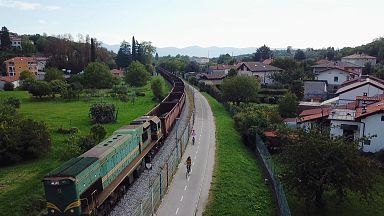With over one-third of Europe's population living on its borders, a new EU initiative, the EGTC, hopes to provide a way of improving cross-border cooperation within the union.
A new bicycle and pedestrian path is part of a European project called Isonzo-Soča Cross-border Park, which links the Italian city of Gorizia and the Slovenian cities of Nova Gorica and Šempeter-Vrtojba.
The three are part of the same urban sprawl straddling two languages and two cultures.
Peter Szabo uses the cycle path several times a day. The project promotes links and sustainable mobility of the cross-border city, Gorizia-Nova Gorica, which in 2004 was one of the symbols of EU enlargement, after decades of being divided.
"When the border was closed in 1945 and until 1947, it was not possible to cross from one country to another, and even after '47, it was the Iron Curtain. This project has the advantage of linking all the small sections of cycle paths that already exist into a single network, a big eight of cycle paths that go to Slovenia and Italy. So there is no border, because you are a bit here and there, and being able to do it by bike is obviously much more comfortable." Explains Peter.
The project for this inter-city and Cross-border Park has a total budget of 5 million euros, 85% of which - exactly 4250000 euros of ERDF funds - comes from the European Cohesion Policy. The remaining 15% is co-financed by Italy and Slovenia.
Another key element of the project is a footbridge, which was inaugurated in October 2022.
According to Tomaž Konrad, Coordinator of the Isonzo-Soča Park, the project aims to return the river to the citizens. The river is called Isonzo in Italian, and Soča in Slovenian.
"The Isonzo-Soča River is the main protagonist. It does not divide two countries, it does not divide three communities, the beautiful thing is the people. Now we have this bridge that symbolises a new direction in Europe, Active mobility." Explains Tomaž, adding, "The three municipalities, as well as the surrounding area, are visited by around 200,000 tourists every year. With the new cycle path and footbridge, we expect to increase the annual number of visitors by 1%, or 2,000 people."
On both sides of the Isonzo-Soča, there are vineyards. The Fiegl estate produces 130,000 bottles per year. The discovery and preservation of this cross-border area's natural and cultural heritage is another objective of this initiative, in which the wine producers are involved.
Martin Fiegl, is Vine Grower and CEO, of Fiegl Viniln Oslavia, "In addition to the cycle path, we as producers have also created a route where people can also walk and visit the various viewpoints."
Europe is forging new links, Nova Gorica and Gorizia will be together with Chemnitz, in Germany, as the European Capitals of Culture in 2025.












